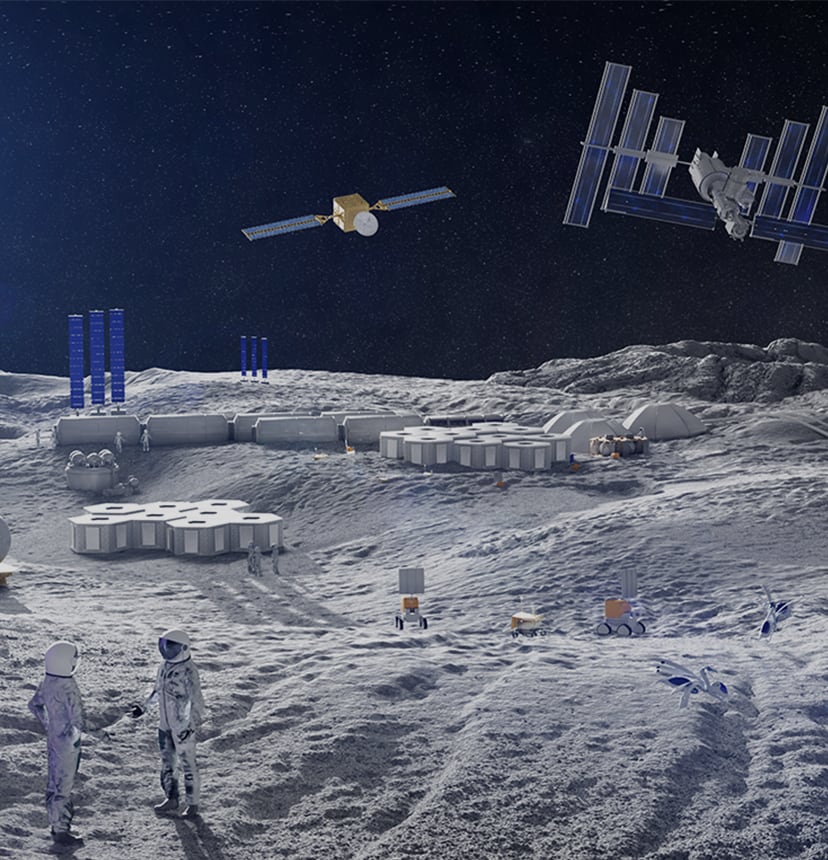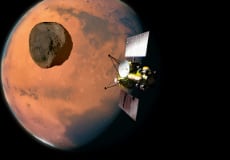The future of human space exploration—to the Moon, Mars, and beyond
Beyond low Earth orbit where the ISS operates, further away from the earth, human space activities will become a reality in the near future with international collaboration. JAXA has accumulated vast amounts of technology and expertise through its human space programs —such as the Japanese Experiment Module “Kibo” and transfer vehicle “KOUNOTORI”—and its robotic missions by science probes including Hayabusa, Hayabusa2, and KAGUYA. Expectations are high for JAXA to use this knowledge and contribute to the advancement of international human space activities.
Meanwhile, the Space Exploration Innovation Hub Center is garnering attention for its innovative framework to promote industry and space development. Specifically, it is proactively applying on-the-ground technologies to space exploration, and vice versa.
A range of missions are underway to ensure that humans can engage in sustainable activities on the Moon and on Mars.

The Artemis Plan—Revisiting the Moon
NASA’s lunar exploration programs are collectively called as the Artemis Plan. It aims to send humans to the Moon surface no earlier than 2027. Through the Gateway (an outpost orbiting the Moon) and other programs, the goal is toto establish sustainable human activities on the Moon by transporting supplies and construct a Moon base.
To further promote the Plan, in October 2020, eight countries, namely the USA, Japan, Canada, Italy, Luxembourg, the UAE, the UK, and Australia, signed the Artemis Accord, affirming, among other things, that all activities will be for peaceful purposes. Please see this page for the Accord:
The Gateway Program—a transit point to the Moon and Mars
Gateway (a lunar orbiting outpost) was first proposed by the USA and is currently under examination by the nations involved in the ISS. The completion is targeted no earlier than 2031. JAXA is presently developing the HTV-X transfer vehicle to transport supplies to the ISS, and studying ultimately to use it for the Gateway.

The Crewed Pressurized Rover—a motorhome on the Moon?

This crewed pressurized rover will be installed with the functions and spaces necessary to accommodate astronauts without a space suit for a fixed amount of time. Astronauts will also be able to board and alight the rover with their space suits on. The rover will be able to continuously travel across large areas of the lunar surface and can be controlled manually or remotely and autonomously. Functions that greatly increase the range of mobility are essential to stimulating activities on the lunar surface.
To promote sustainable lunar activities, JAXA is aiming to use the crewed pressurized rover to pioneer a lunar society. As such, it is hosting the Team Japan Study Group with a number of associated companies. Using the rover as a launchpad for discussion, the study group facilitates the exchange of opinions from diverse industries, and aims to create a practical vision for the lunar society of the future.
*The study group is a membership organization. Please see the link for more details.
*There are no scheduled study group sessions as of November 2025.
Lunar Polar Exploration (LUPEX)
〜Searching for water on the lunar south polar region〜
LUPEX’s objective is to collect data on the quantity and quality of water resources and its concentration principles in order to determine the extent lunar water resources can be used for future sustainable space exploration activities.

Building reliable partners for astronauts—using robotics to support human space activities

A number of robots, such as JAXA’s JEM Internal Ball Camera (Int-Ball) used in Kibo、are currently in use at the ISS. These robots move autonomously around the ISS taking stills and videos, transmitting them in real time to flight controllers and researchers on the ground.
In this way, not only can robots reduce astronauts’ workloads, they can also take their place in dangerous situations. Developments in robotics will be key to the future of human space explorations. In-orbit demonstrations have now commenced using Int-Ball2, the second unit following Int-Ball, and it has already completed multiple missions.
JAXA utilizes on-the-ground robotic technologies to increase the efficiency and safety of human space activities and aims to enhance the quality of life for all of us, humans, by providing feedback to on-the-ground technologies.
Japanese astronauts on the Moon
In autumn 2021, JAXA will begin recruiting candidates to become new astronauts. Not only will these individuals work in low Earth orbit, they will be active at the Gateway and on the lunar surface. It won’t be long, then, until a Japanese astronaut sets foot on the Moon.

Unless specified otherwise, rights to all images belong to ©JAXA






